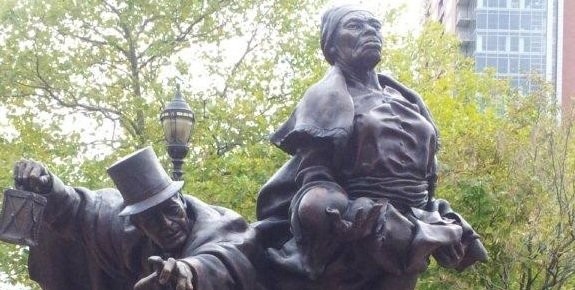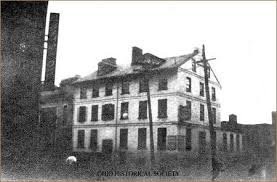Thomas Garret Station Master on the Underground Railroad
Introduction
Text-to-speech Audio
Images
Statue of Thomas Garrett and Harriett Tubman

Thomas Garrett home in Wilmington, Delaware

Backstory and Context
Text-to-speech Audio
Thomas Garrett was born
in Upper Darby, Pennsylvania on August 21, 1789. His family had been hiding
fugitive slaves in the farmhouse ever since he was a child. The very first time
he had ever helped a slave was when the family servant was kidnapped from her
quarters late in the night in the year 1813. Garrett married Mary Sharpless of
Chester County, Pennsylvania, and by February 1819 they had 3 children together,
two girls and one boy. In 1822, the Garrett family moved to Wilmington, Delaware, the northernmost town of the slave state. This town was only
five miles away from the Pennsylvania state border; Chester County was the
epicenter of abolitionism. This is important because Pennsylvania was a free
state, which means if a slave made it there, they were free. After moving to
Wilmington, Garrett went into the iron and hardware business, then opened his
home on Shipley street to fugitive slaves trying to get to freedom. Two
years after the family moved to Wilmington, their second son Henry was born and
then their third daughter was born.
In June of 1818, Garrett had joined the Pennsylvania Society for
the Promotion of the Abolition of Slavery. The organization was founded in 1775
but was not recognized until 1784 and went by the name The Relief of Free Negros
Unlawfully Held in Bondage. This was the very first abolitionist society to be
recognized in America. Anthony Benezet and Thomas Paine were two of the members
that play a large role in American history. Anthony Benzet was an
educator as well as an abolitionist who helped found the society. Thomas
Paine was a political activist during the Revolutionary war, and was against
slavery from the beginning. Benjamin Franklin was the first elected President
of the society, and he also petitioned the U.S. Congress in 1790 to ban slavery
altogether.
Thomas Garrett helped save over 2,700 slaves in his 40-year
career as a stationmaster at his home. One of the families that Garrett saved
was the Garnet family in 1824. The Garnet family of eleven was given permission
to go to a funeral but they escaped from the covered wagon that was carrying
them while it was stopped. They first traveled to Garrett's station in
Wilmington, and from there to New York City. The Hawkins family was also helped to
freedom in December by Thomas Garrett. Samuel Hawkins was a free man, but his
wife and six children were enslaved. His family was apprehended at John Hunn's
Underground Railroad Station, and then taken to New Castle County Jail. Garrett
heard what was happening and took the fugitives before Judge Booth, Chief
Justice of Delaware, on the writ of Habeas Corpus. The judge ordered that the
fugitives were to be released. Garrett ordered a coach from the Underground
Railroad to help get them to Pennsylvania. After these events Garrett and Hunn
were both sued for harboring fugitive slaves. John Hunn had two trials, where
Thomas Garrett had four. Charles Glanding and his wife, the owners of the
Hawkins family, sued Garrett for $5400.
In 1870, the fifteenth amendment passed to give African
Americans the right to vote. On this day the African Americans hoisted Thomas
Garrett on their shoulders, hailing him at their Moses. Thomas Garrett was one
of the most influential abolitionists during the Underground Railroad. Garrett
was the inspiration for Simeon Halliday in the novel Uncle Tom's Cabin written by Harriet Beecher Stowe. On January 25, 1871
Thomas Garrett died at 89 of natural causes.
Sources
Parker, Mariah. Quakers and Slavery. Brynmawr. . Accessed September 29, 2018. web.tricolab.brynmawr.edu/specoll/quakerandslavery/commentary/people/garrett.php.
Thomas Garrett. Quakers in the World. . Accessed September 29, 2018. www.quakersintheworld.org/quakers-in-action/122/Thomas-Garrett.
Pinsker, Matthew. The Underground Railroad. America in Class. . Accessed September 29, 2018. americainclass.org/the-underground-railroad.
Feliz, Eylce. Thomas Garrett. Civil War Blogspot. August 21, 2014. Accessed September 29, 2018. http://civilwaref.blogspot.com/2014/08/thomas-garrett-born-august-21-1789.html.
